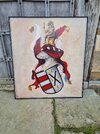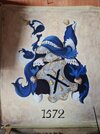Claus
Dagobah Resident
First of all I wish you all a great day!
Now to my question, maybe it is ridiculous, but this one comes back to me every now and than, and maybe this signs are a sign for us, to show that even if a country do not have monarchy anymore, they still use the coats of arms they had in that time.
So I pondered about that. Is it because it was convenient, or should there be a hidden message?
It also could be because of "posing" (I don't know if it is the correct word for it, but show of isn't the right therm either.)
But it also could be a sign (for something that we allready know), the true form of government has never been changed, and monarchy was not the true form of government either.
What do you think about that? Is it a thing to go after, or is it ridiculous?
Now to my question, maybe it is ridiculous, but this one comes back to me every now and than, and maybe this signs are a sign for us, to show that even if a country do not have monarchy anymore, they still use the coats of arms they had in that time.
So I pondered about that. Is it because it was convenient, or should there be a hidden message?
It also could be because of "posing" (I don't know if it is the correct word for it, but show of isn't the right therm either.)
But it also could be a sign (for something that we allready know), the true form of government has never been changed, and monarchy was not the true form of government either.
What do you think about that? Is it a thing to go after, or is it ridiculous?







